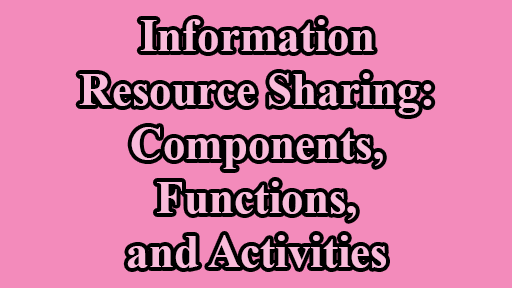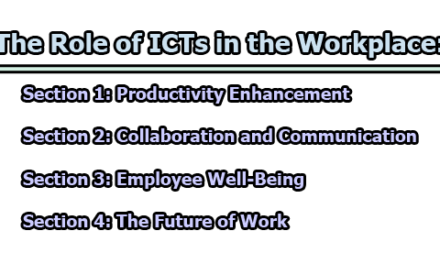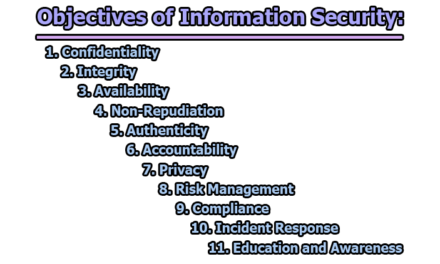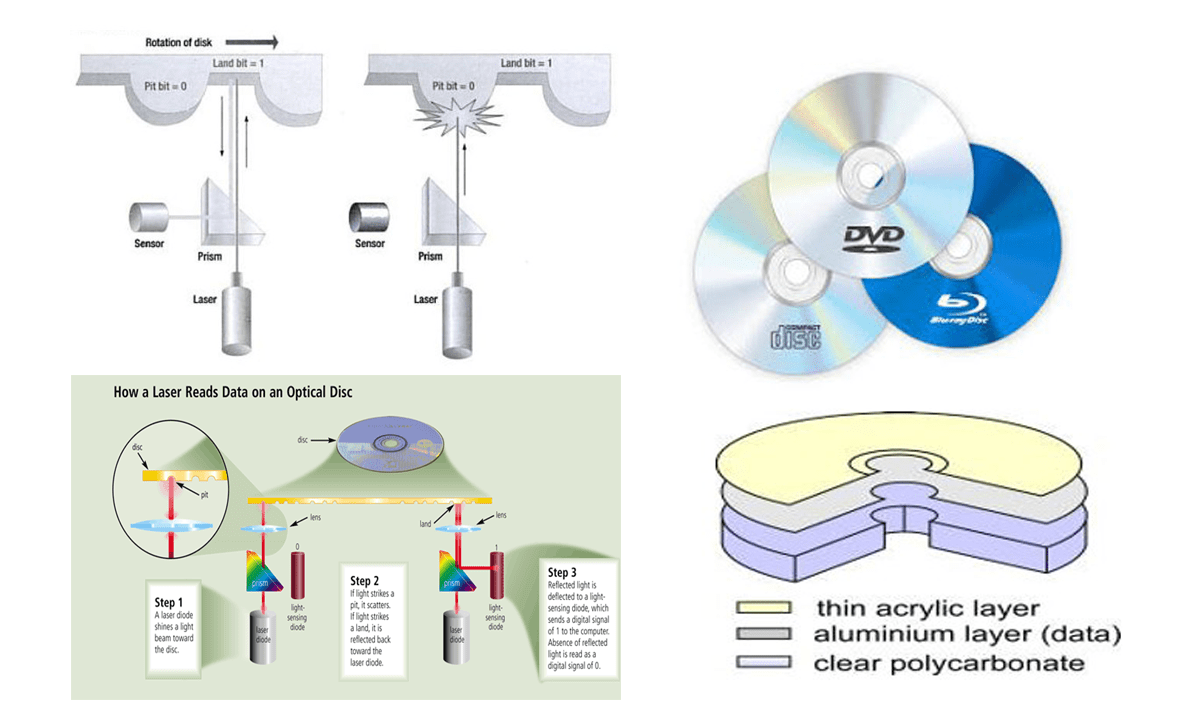Information Resource Sharing: Components, Functions, and Activities
Information resource sharing is a fundamental aspect of modern society, driven by advances in technology and the increasing complexity of information systems. In an era where information is considered a valuable asset, organizations, institutions, and individuals rely on the exchange of data and knowledge to make informed decisions, enhance productivity, and foster collaboration. This article explores the various components, functions, and activities involved in information resource sharing, shedding light on its significance and impact in contemporary contexts.
Components of Information Resource Sharing:
1. Information Resources: Information resources are the raw materials of information sharing. These encompass a wide array of data, including:
- Textual Content: This includes documents, reports, articles, books, and other written materials. In academic settings, these may be research papers and textbooks, while in businesses, it could be internal reports or manuals.
- Multimedia Content: Videos, images, audio recordings, and animations constitute multimedia content. Media organizations share news videos, while e-learning platforms share instructional videos.
- Databases: Structured data stored in databases, often containing vast amounts of information. In healthcare, Electronic Health Records (EHRs) are a prime example, enabling the sharing of patient information among medical professionals.
- Archives: Historical records, manuscripts, and collections of documents that are preserved and shared for research and reference purposes. National archives store important historical documents, while academic archives may house special collections.
2. Information Technologies: Information technologies are essential for managing and facilitating the sharing of information resources. These encompass:
- Hardware: Servers, data storage devices, and networking equipment are foundational to information sharing. Data centers host vast repositories of digital information, while cloud infrastructure enables scalable resource sharing.
- Software: Content Management Systems (CMS), Document Management Systems (DMS), and Knowledge Management Systems (KMS) are software tools that organizations use to organize and share information efficiently. Examples include SharePoint and Dropbox for businesses and Omeka for cultural institutions.
- Networking Infrastructure: High-speed internet connections, routers, and switches are critical for sharing information across local and global networks. Technologies like Virtual Private Networks (VPNs) secure data during transmission.
- Collaboration Tools: Video conferencing platforms, email clients, and project management software enable real-time collaboration and information sharing among teams. Examples include Zoom, Microsoft Teams, and Slack.
3. Human Resources: Human resources are the people who manage, curate, and disseminate information resources. They include:
- Librarians and Information Specialists: In academic and public libraries, librarians curate collections and assist users in finding and accessing information resources.
- Data Analysts and Scientists: In research institutions and data-driven organizations, data professionals analyze and share data to derive insights and support decision-making.
- Knowledge Managers: In businesses, knowledge managers are responsible for capturing, organizing, and sharing institutional knowledge among employees.
- Archivists: In cultural institutions and archives, archivists preserve and manage historical records, making them accessible to researchers.
4. Policies and Standards: To ensure the responsible and effective sharing of information resources, organizations rely on policies and standards, which may include:
- Copyright and Intellectual Property Policies: These define how copyrighted materials can be used, shared, and reproduced, ensuring compliance with intellectual property laws.
- Data Governance Policies: Organizations establish data governance policies to maintain data quality, privacy, and security during information sharing.
- Access Control Policies: These policies dictate who can access specific information resources and under what conditions, protecting sensitive data from unauthorized access.
- Open Access and Licensing Policies: Academic institutions and publishers may adopt open access policies, allowing for the free and unrestricted sharing of research outputs, or use Creative Commons licenses to specify usage rights.
- Data Retention and Archiving Policies: Organizations define how long information resources should be retained and how archived data should be managed.
- Compliance with Industry Regulations: Certain industries, such as healthcare (HIPAA) or finance (Sarbanes-Oxley Act), have specific regulations governing information sharing that organizations must adhere to.
Functions of Information Resource Sharing:
1. Access and Retrieval: One of the primary functions of information resource sharing is to provide users with easy access to relevant information. This function involves:
- Information Discovery: Making information resources discoverable through various means such as catalogs, search engines, and metadata. Libraries and digital repositories use cataloging and indexing to facilitate resource discovery.
- User-Friendly Interfaces: Developing user-friendly interfaces that allow individuals to search for and retrieve information efficiently. This includes search engines, online catalogs, and navigation menus on websites.
- Quick Retrieval: Ensuring that users can access information rapidly, reducing the time and effort required to find the data they need. This is particularly important in research and decision-making processes.
2. Dissemination and Distribution: Information sharing extends beyond internal use and often involves the dissemination and distribution of data to broader audiences. Key aspects of this function include:
- Publication: Academic institutions publish research findings in journals, conferences, and books. Likewise, news organizations publish articles, videos, and other content for public consumption.
- Marketing and Promotion: Businesses distribute marketing materials to potential customers, including advertisements, product catalogs, and promotional videos.
- Information Sharing Platforms: Creating platforms for sharing information with specific target audiences. For example, academic institutions maintain online repositories for sharing research outputs with the global research community.
- Distribution Channels: Identifying and utilizing appropriate distribution channels, such as print media, websites, email newsletters, and social media, to reach the intended audience.
4. Collaboration and Communication: Information resource sharing plays a vital role in fostering collaboration and communication among individuals and groups. Key functions include:
- Collaborative Workspaces: Providing tools and platforms for collaborative work, allowing multiple users to access and edit shared documents in real time. Examples include Google Workspace and Microsoft Teams.
- Knowledge Sharing: Encouraging knowledge sharing within organizations through wikis, forums, and internal social networks. This helps in preserving institutional knowledge and fostering innovation.
- Communication Channels: Facilitating communication through email, instant messaging, and video conferencing tools, enabling teams to share information and ideas regardless of physical location.
- Project Collaboration: Supporting project management and collaboration by sharing project-related documents, schedules, and progress reports among team members.
4. Preservation and Archiving: Preservation is a critical function of information resource sharing, ensuring that valuable information is safeguarded for future use. Key elements of this function include:
- Archiving Historical Records: Maintaining archives of historical documents, manuscripts, and records that hold cultural, historical, or legal significance. National archives often perform this function.
- Digital Preservation: Implementing strategies and technologies to preserve digital assets, such as websites, databases, and multimedia content, from obsolescence and data loss.
- Version Control: Managing different versions of documents and data to track changes and ensure that historical records remain intact and accessible.
- Long-Term Storage: Storing information resources in a way that ensures their integrity and accessibility over extended periods, which may involve migration to new formats or media.
Activities of Information Resource Sharing:
1. Cataloging and Metadata Creation: Cataloging is a foundational activity in libraries and digital repositories. It involves organizing and describing information resources so that users can easily find and access them. Key activities within cataloging include:
- Metadata Creation: Generating metadata for each information resource. Metadata includes details such as title, author, publication date, keywords, and subject classifications. These descriptors help users search for and identify relevant resources.
- Classification and Categorization: Assigning resources to appropriate categories or subject classifications. In libraries, this often involves using systems like the Dewey Decimal Classification or Library of Congress Classification.
- Indexing: Creating indexes or search databases that allow users to search for resources by keywords, subjects, or other criteria.
- Catalog Maintenance: Regularly updating the catalog to reflect changes in the collection, such as new acquisitions or resource updates.
2. Interlibrary Loan Services: Interlibrary loan services are common in academic and public libraries. These services allow patrons to borrow materials from other libraries within a network or consortium. Key activities include:
- Request Handling: Managing requests from patrons who want to borrow materials not available in their home library.
- Resource Sharing Agreements: Establishing agreements with other libraries to facilitate resource sharing.
- Lending and Borrowing: Coordinating the lending and borrowing of materials, including tracking due dates and returning borrowed items.
3. Data Sharing and Open Access: Data sharing is crucial in research and academic communities, promoting transparency and collaboration. Activities in this area include:
- Data Publication: Publishing research data alongside research articles to allow for reproducibility and further analysis.
- Data Repositories: Managing data repositories that store and provide access to datasets. Examples include institutional repositories and domain-specific data archives.
- Open Access Journals: Supporting open access journals that make research articles freely available to the public, increasing the dissemination of knowledge.
- Data Licensing: Defining licensing terms for shared data to specify how others can use, share, and modify it.
4. Content Licensing and Copyright Compliance: In content-rich environments, such as publishing and media, activities related to licensing and copyright compliance are crucial:
- Rights Acquisition: Negotiating and securing the rights to use and share copyrighted materials. This includes purchasing licenses, obtaining permissions, and adhering to fair use guidelines.
- Copyright Clearance: Ensuring that all content used in publications, broadcasts, or other media adheres to copyright laws and licensing agreements.
- Digital Rights Management (DRM): Implementing DRM technologies to protect digital content from unauthorized distribution or use.
5. Information Security and Privacy: Protecting sensitive information is an ongoing activity in information resource sharing, especially in contexts like healthcare, finance, and government:
- Access Control: Implementing access controls to restrict who can access certain information resources and under what circumstances. This includes user authentication and authorization processes.
- Encryption: Encrypting data during transmission and storage to safeguard it from unauthorized access or interception.
- Data Privacy Compliance: Ensuring compliance with data privacy regulations, such as the General Data Protection Regulation (GDPR) in Europe or the Health Insurance Portability and Accountability Act (HIPAA) in healthcare.
- Incident Response: Developing and implementing protocols for responding to data breaches or security incidents swiftly.
6. Resource Maintenance and Preservation: Maintenance and preservation activities ensure that information resources remain accessible and usable over time:
- Regular Backups: Conducting regular backups of digital information to prevent data loss due to hardware failures, data corruption, or disasters.
- Data Migration: Migrating data to new formats or storage systems to ensure compatibility and prevent data obsolescence.
- Preservation Planning: Developing preservation strategies, including identifying valuable resources, assessing preservation risks, and setting priorities for preservation efforts.
- Metadata Preservation: Ensuring that metadata remains intact and accessible, as metadata is crucial for resource discovery and context.
- Digital Object Identifiers (DOIs): Assigning DOIs to digital objects, such as research articles and datasets, to provide a permanent and citable link to the resource.
In conclusion, information resource sharing is a multifaceted process involving various components, functions, and activities. As technology continues to evolve, the ways in which information is shared and accessed will also transform. Understanding the key components and functions of information resource sharing is essential for organizations and individuals to harness the power of information in the digital age.
References:
- American Library Association (ALA). (n.d.). Interlibrary Loan (ILL). Retrieved from http://www.ala.org/advocacy/interlibrary-loan
- Borgman, C. L. (2015). Big Data, Little Data, No Data: Scholarship in the Networked World. MIT Press.
- Chua, A. Y. K. (2015). Information Resource Description: Creating and Managing Metadata. Facet Publishing.
- Digital Public Library of America (DPLA). (n.d.). About DPLA. Retrieved from https://dp.la/about
- Hernon, P., & Schwartz, C. (2015). Collection Management Basics. American Library Association.
- International Federation of Library Associations and Institutions (IFLA). (2016). Guidelines for Best Practice in Access to Government Information.
- Kaur, H., & Bansal, D. (2016). Information resource sharing through social networking sites: A survey. Library Philosophy and Practice, 1409.
- National Information Standards Organization (NISO). (2018). NISO RP-19-2018: Outputs of the Resource Sync Prototype Project.

Library Lecturer at Nurul Amin Degree College










